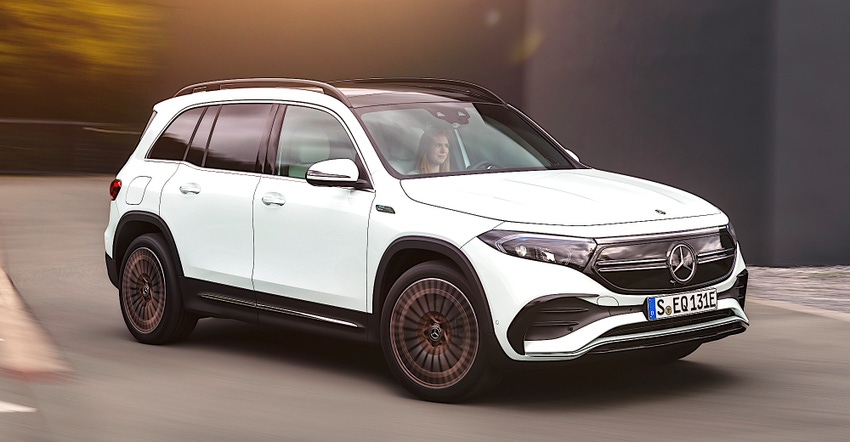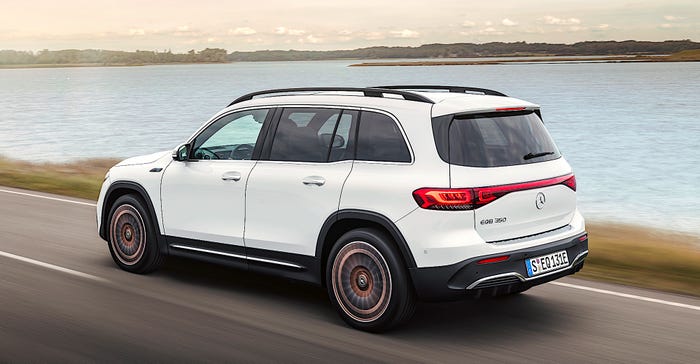2023 Mercedes-Benz EQB250 Strikes the EV Price/Range Balance
The EQB250 makes Mercedes-Benz a legitimate value player in the pricy EV market.

An unexpected side-effect of the run-up in new car pricing is that Mercedes-Benz has a solid claim to the title of value leader with the EQB250, a $53,900 (base price) battery-electric compact crossover with an EPA-estimated driving range of 245 miles.
It is possible to run up the price tag of the EQB, one of Mercedes’ smaller EVs, by adding more power, all-wheel-drive, and an optional third row of seats. But my budget-minded test car was equipped the way I’d prefer, with an eye toward holding the line on costs.
That means that the EQB250 is equipped with the 188-horsepower, 284-lb.-ft. single motor driving only the front wheel. This combination produces more-than-acceptable acceleration for a family car and includes plenty of luxury options like the panoramic sunroof.
I’d splurge to get some color rather than the no-charge white paint on the test car (black is also free), but the only paint with any actual pigmentation is a bright red that costs $1,700. Still, I think it would be worth it to avoid the dull monochromatic monotony that has seized modern roads. And no, the fairy tale about insurance costing more for red cars is not true.
The test car’s bottom line is $60,410, which after my regular experience of sticker shock looking at most new cars, came as a pleasant surprise. According to Kelley Blue Book, the average transaction price for a new car in the U.S. is $48,334 and the price for an EV averaged $53,469 in July. Hold the line on options (so long red paint!), and you’ve got a Mercedes-Benz for the price of an average EV.
Because it does have a reasonable price, the EQB250 does not have a gigantic battery and you will not find YouTube choked with videos of EQBs smoking Dodge Hellcats at the drag strip, as is the case with some expensive EVs. Mercedes says that it accelerates to 60 mph in a shade less than 8 seconds. I didn’t do any acceleration tests, but that feels accurate, meaning that it is as quick as typical sports cars of a generation ago.
The battery pack holds 66.5 kilowatt-hours, and the car averaged 3.4 miles per kWh during its time with me, which extrapolates to a range of 226 miles if I had dared run the battery completely dead. The car’s computer forecast a driving range of 292 miles. A 130-mile highway drive dropped the range prediction to 115 miles, which suggested that even the 226-mile rating is optimistic during highway driving which was about half at 60 mph and about half at 70 mph.
I used the EQB’s adaptive cruise control for much of the highway driving, expecting that it could deliver a smooth application of power to optimize driving range. The system works well, though, on a highway that eventually had a traffic signal, it was very surprised to come upon stopped cars while driving 60 mph. It did not brake until very late, causing unnecessary consternation on my part while I hovered my foot over the brake pedal waiting to see what it would do. Suboptimal.
Similarly, the active steering assistance did a good job of keeping the EQB centered in the lane with no effort on my part, while also not wrestling with me for control, which is the downfall of most such systems, causing me to turn them off. On one particularly long straight, however, it concluded from the lack of conflict that I had no hands on the wheel and popped up an alert to put my hands on the wheel.
I wasn’t sure how to inform it that my hands were in fact on the wheel. Gripping the rim more tightly didn’t make any difference, and it continued to alarm. So finally I just yanked on the steering and gave it an aggressive wiggle in the lane, which placated the computer. That was the sole hiccup in my use of the Active Steering Assist on the highway.
A battery EV that is good for more than 200 miles in fast highway driving that provides Mercedes-Benz comfort and amenities for $60,000 (or less) is a bargain. Probably because of the smallish battery capacity, DC fast-charging capability is only 100 kilowatts.
Mercedes says that is good enough to charge from 10 percent to 80 percent state of charge in 32 minutes, but my experience says that a more powerful charger would make this more likely. At least 150 kW, to exploit the more common DC fast chargers, would be helpful, even if 350 kW charging remains impractically expensive for a vehicle in this price range. Yes, Hyundai and Kia provide 350 kW charging in similarly priced models, but those cars surely save money in other areas where Mercedes has been more lavish on the EQB.

My home 9.6-kW ChargePoint Level 2 AC charger ran at a consistent 9.5-kW charging the EQB, delivering quick home charges. A note about the car’s charge port, however: Under the outer door, which is similar to that of the fuel door in a gasoline car, the EQB’s SAE J1772 AC charge port and Combined Charging System DC port are covered by hinged doors, which makes them easier to close than vehicles that have removable rubber plugs that the driver has to stick back into the port, which is annoying in the daylight and sometimes difficult in the dark.
That’s good. However, if you just slap the outer door shut, or try to, it jams on the port covers rather than levering them closed. A little thought put into the inner contours of the outer door would let drivers slam that shut and close the inner covers at the same time. Details like this add up when it is an action that you are doing every single day.
The EQB’s front seats are very comfortable, and the seat controls are blessedly on the door panel instead of being controlled on the infotainment screen, so life is simpler in this respect. I’d still prefer a rotary volume knob on the dashboard, but roller knobs on the steering wheel and console aren’t bad.
The test car had solid black interior upholstery, which even with the panoramic sunroof, made the cabin too dark. There’s a beige alternative for no cost that provides a lighter atmosphere, so that would be my choice. Plus, it would look good with the red paint!
The back seat has two good seating positions and a middle seat that can only be considered viable for short hops or maybe as the anchor position for an infant seat. Front and rear seats on both the left and right sides have grab handles above the door openings, which is a feature missing from too many cars.
The test car was not equipped with the optional third row, which is good, because there’s just not enough space back there for a useable third row. There is enough space for a really large cargo area, though, which makes the EQB very practical for household hauling duties.
Ride and handling are excellent, even in the base model without the available Adaptive Damping system. Too many new vehicles are built with Nurburgring lap times apparently as a priority and deliver decent handling (not great, because EVs weigh too much for that and SUVs are too tall) at the price of a punishing ride. That’s not the case here. Abandoning track pretensions let the EQB deliver a cushy day-to-day ride with perfectly good steering response.
Such considerations matter, because the EQB250 has earned a spot on my personal “would buy” list. This is unusual, in a world of too-expensive, too-uncomfortable, and/or too thirsty vehicles. The EQB250 strikes the right balance between price and range available with today’s technology.
About the Author(s)
You May Also Like





